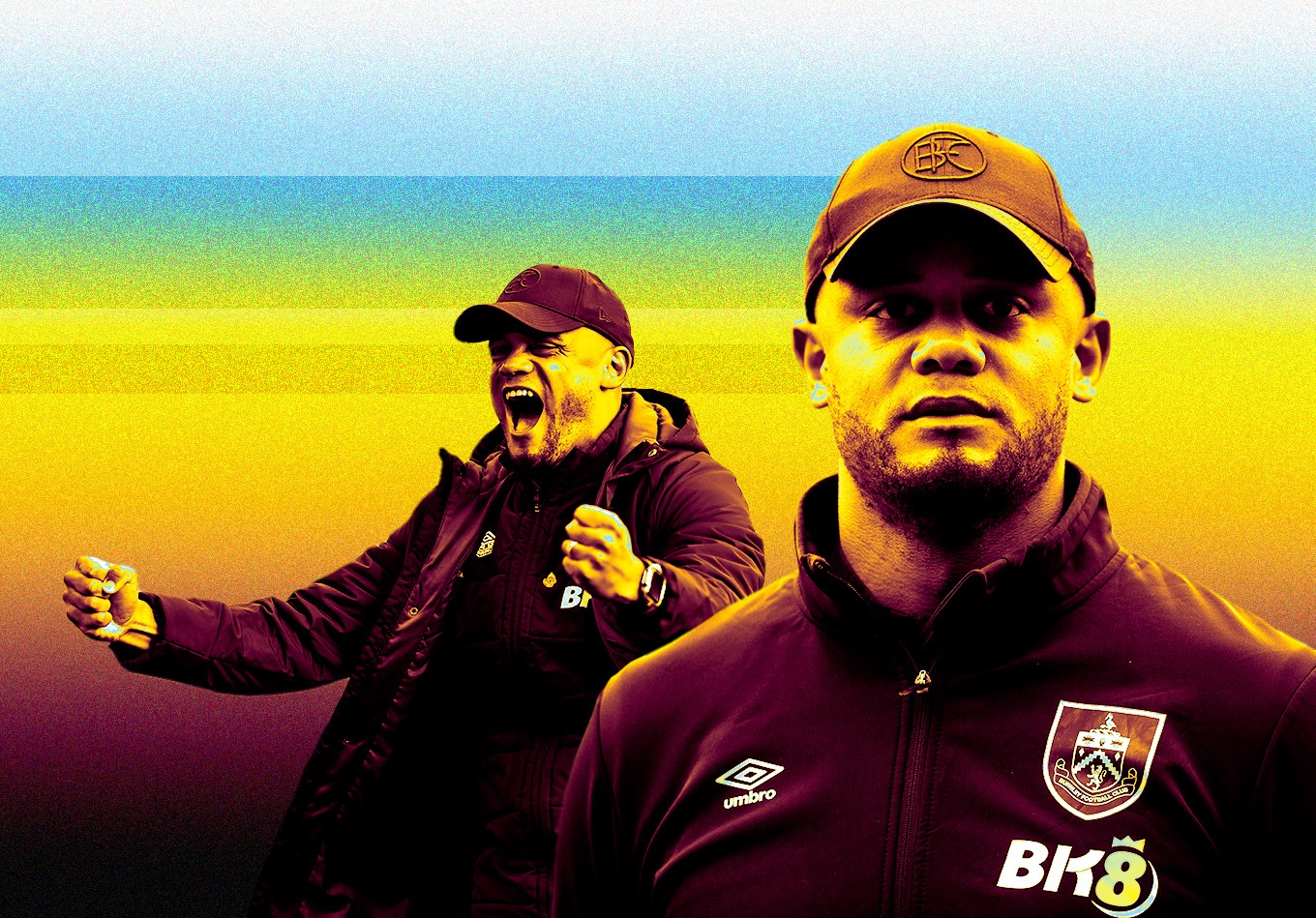Pep Guardiola signed a two-year extension to his contract as Manchester City boss last month.
A sign that the Catalonian is very happy in his current position, in one sense, yet put another way, he hasn’t penned a four or five-year deal, which may well have been on the table for the person many see as the best manager in the world.
As such, it’s not unreasonable to suggest that Guardiola plans to have a sabbatical in 2025, after nine years in post and 12 in management, stretching back to his Bayern Munich tenure.
It is highly audacious to look this far in the future, and much can happen between now and then which would throw off course any current theories on succession.
One possible trajectory, however, is that Vincent Kompany wins the Championship title with Burnley this season, keeps them up comfortably in the Premier League in 2023-24 before recording a top half finish the following season.
By this point, the Belgian would have likely hit a glass ceiling with the Clarets and be keen to embark on his next chapter, while City may be prepared to take a chance on him with the managerial potential he’d have shown, combined with the added dimension of his history with the club.
Could this really happen? What sort of a fit would Kompany be, two-and-a-half years down the line?
Playing Style
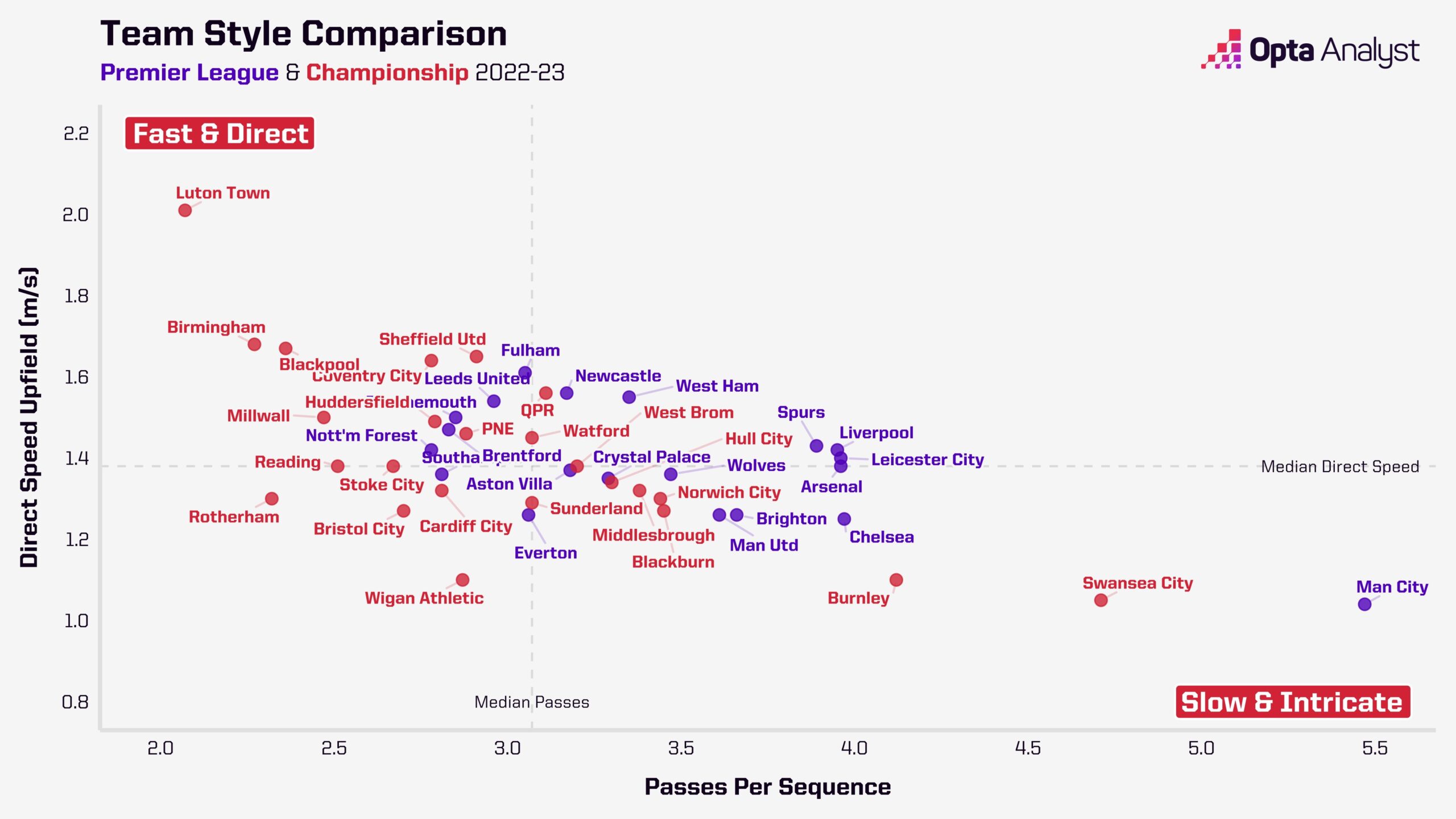
Having experienced Pep Guardiola’s methods first-hand for four years, Kompany is a heavily possession-based coach.
His Burnley side average 63.6% possession in contrast with Man City’s 66.6%, and 466.3 successful passes per game to City’s 610.1. In both cases, the Clarets rank in the top four highest across the top two tiers of English league football.
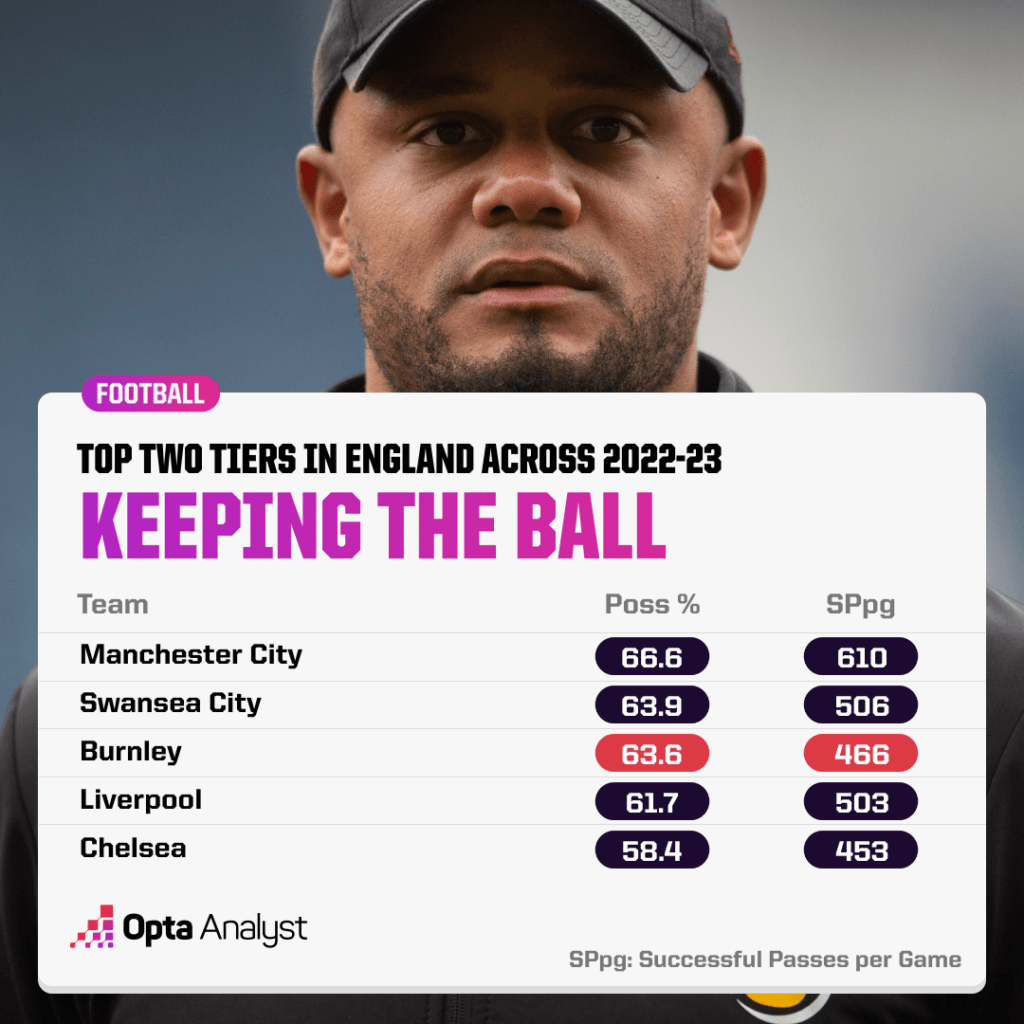
The job that Kompany’s done to change Burnley’s playing style in such a short space of time can’t be underplayed. Signing so many new players and getting them to produce successful results in under six months must be applauded.
Under previous boss Sean Dyche, Burnley averaged 228 successful passes per game and 42.8% possession – much lower than their equivalent metrics in 2022-23 under the Belgian.
Of course, the East Lancashire club have some budgetary advantages in the Championship, having been able to reportedly spend just shy of £29 million on players for the first-team squad – the most in the league – thanks to the parachute payments from their time in the Premier League.
At the same time, six of the 10 first team signings are under 24, and there was a significant emphasis on evolving what had been an aging squad and increasing the long-term value, as much as an immediate expectation to win the title.
By contrast, Man City are broadly expected to dominate: their possession and successful passes per game metrics reflect a few more contests than Burnley have had in which opponents set up with a deep block.
Stylistically, therefore, Kompany’s methods are very similar to those of his former boss, though there is a willingness to maximize transitional opportunities when stealing the ball high up – and quicken the pace on the flanks…
Accelerating Play out Wide
Kompany wants his side to draw the press by being incredibly patient in possession in their own half, circulating play through a central quintet of Connor Roberts or Vitinho, Taylor Harwood-Bellis, Jordan Beyer, Jack Cork and Josh Cullen.
When that press is not forthcoming, Cork and Cullen can turn, see the game in front of them and create from there, but when it is, the game becomes about the wide players.
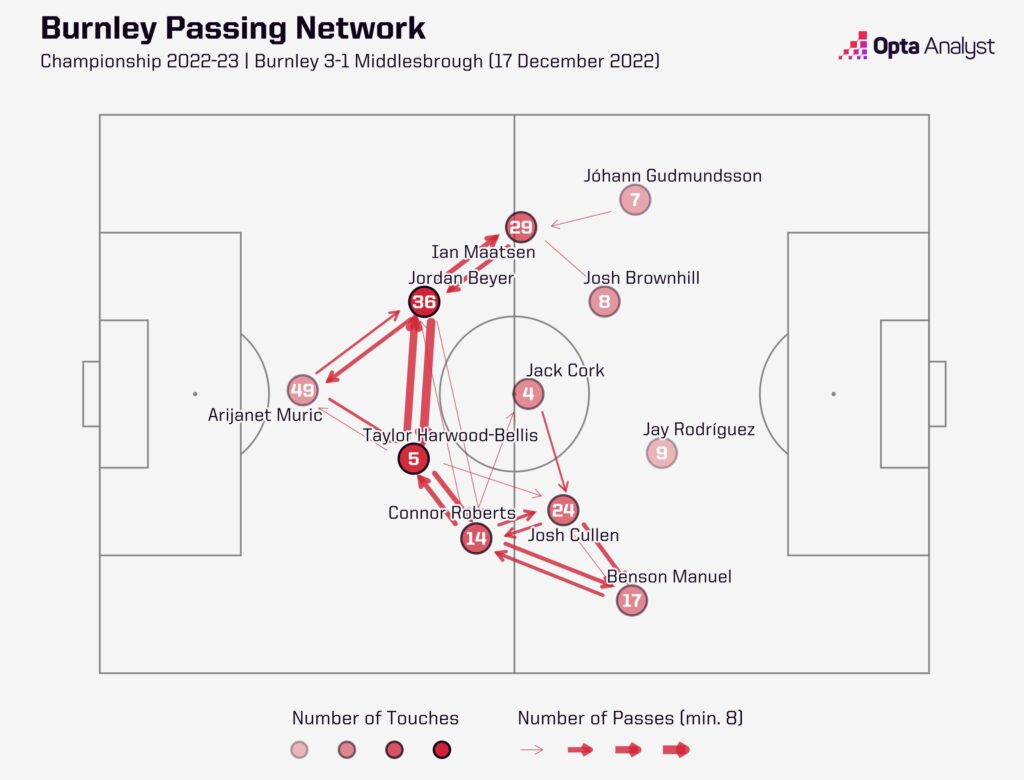
Ian Maatsen’s pace and stamina allows him to get from his own half into the final third very quickly. No full-back in the Championship to play at least 900 minutes has averaged more progressive carries (13) or progressive carry distance (156m) per 90 minutes than he has in 2022-23.
Averaging 0.21 expected assists per 90 minutes, Maatsen is Burnley’s most creative player from open play – the fourth highest in the entire league – and loves a one-two with Cork, Tella, Brownhill or Zaroury before bursting onto the return.
Maatsen has been crucial to Burnley’s attacking output, with an average of 4.7 attacking sequence involvements from open play per 90 minutes this season – 2.4 of those seeing his only involvement in the build-up to the shot.
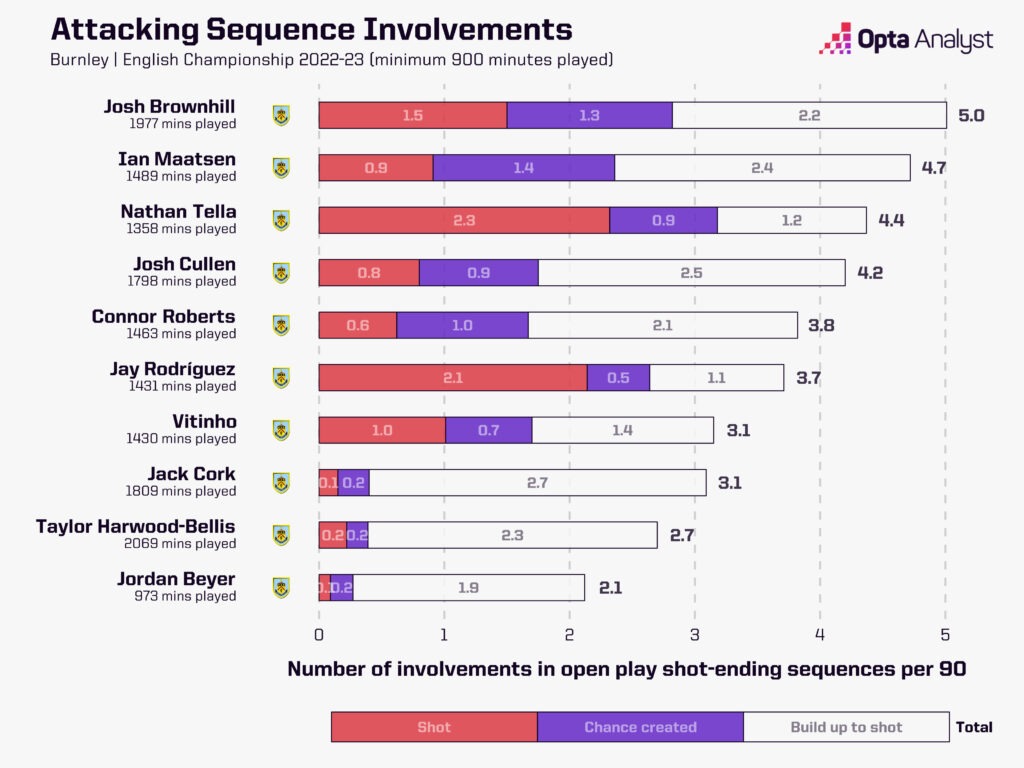
When the diminutive 20-year-old gets on the end of it, he can cut the ball back or produce a low cross for a big chance, but when he doesn’t quite do so, he can still pressurize the opposition.
At 5’6”, Maatsen is nimble, agile and energetic which, coupled with his bravery, makes him incredibly tenacious and thus, Burnley’s most common tackler and interceptor per 90 minutes in the Championship across 2022-23 (3.6 per 90).
As such, the wing-back can still force the opposition into unwanted clearances and misplaced passes when ‘Plan A’ doesn’t quite come off.
It’s plausible that Kompany would want to sign Maatsen, were he to become City boss some time in the future, but he also may be able to do similar work with Sergio Gomez or Josh Wilson-Ebrand.
Being predominantly left-footed, Maatsen is a different type of left-back to Joao Cancelo, more conventional than inverted.
In that sense, Kompany would tweak things slightly by not asking both full-backs to step into midfield when midfielders push forward, as Pep does.
Back-Three-and-a-Half
Vincent Kompany’s favoured system has been a cross between a 4-2-3-1, a 4-3-3 and an asymmetric 3-4-2-1, with the right side lifted slightly higher than the left.
Maatsen, as covered, operates far more like a wing-back than a left-back, while Jordan Beyer is a disciplined left centre-back who tends to sit tight next to the excellent Harwood-Bellis – somebody Kompany may want to build around at City long-term.
By contrast, Connor Roberts or Vitinho are more attacking than Beyer, but not as attacking as Maatsen, so couldn’t be described definitively as a right-back in a four nor a right centre-back in a three but both can play a middling, Kyle Walker type role.
Officially, it’s a back-four, because Manuel Benson seems far too attacking, and capable of cutting inside to threaten, to be considered a right wing-back.
However, the system has elements of a back-three which makes it even more challenging for opponents to pin down.
The weakness would, in theory, be the gap between Benson and Roberts or Vitinho, but because the latter two are so fit, athletic and aggressive, either can close it very quickly and the risk has proved worthwhile for Kompany.
Rotating Single-Pivot
Does Kompany operate with one sitting midfielder, or two?
Controlling possession of the ball in the central zones of the pitch inside their own half is key to Burnley’s style. In those zones – known as zone 5 and zone 8 – Burnley have had 80% of touches in matches, allowing opponents just 20% on average. Compare that to second-placed Sheffield United, who average 65% in zone 5 and 62% in zone 8, then you can see how strong Burnley are in that area. The leading Premier League team in those areas? Manchester City, of course (83% in both).
Technically, the experienced Jack Cork might be the closest thing to Burnley’s ‘sitter’, but he’s not averse to carrying the ball forward delicately and using his experience and nous to win fouls. Josh Cullen also sits at times yet is at other times this team’s most creative player in the final third.
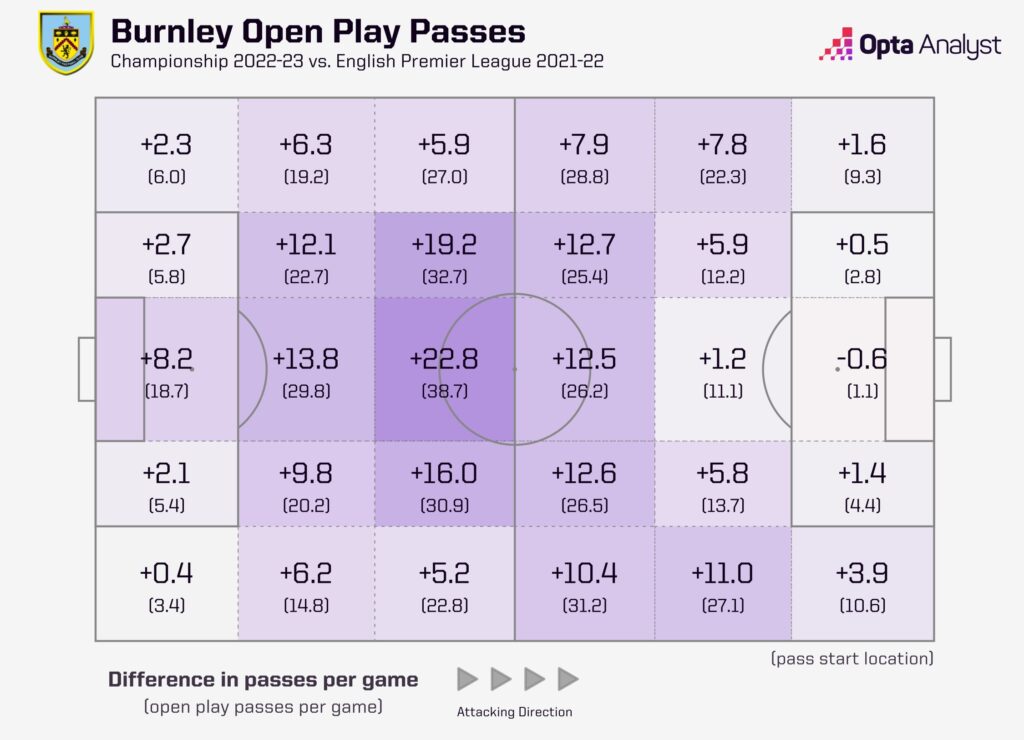
Of course, the data is skewed by the difference in quality of opposition between the Championship and Premier League, but the difference in Burnley’s dominance of possession under Kompany in the centre of the pitch is clear to see in the viz above. Burnley have averaged just over 35 passes more per game in the middle of the pitch (either side of the halfway line) than they did in last season’s top-flight campaign.
In essence, the Clarets don’t operate with a double-pivot, nor a single-pivot: rather, there’s a single-pivot duty that alternates between Cork and Cullen.
Josh Brownhill very rarely drops into that #6 role, and is instead largely freed up to press, create and deliver the big numbers: five goals and five assists.
Although, Brownhill’s experience in a variety of midfield roles under Lee Johnson at Barnsley and Bristol City adds to his dynamic package, and ability to contribute in multiple phases of play, enhancing the unpredictability of this Burnley side.
The relationship between Cork, Cullen and Brownhill is similar, stylistically, to that between Rodri, Ilkay Gundogan and Kevin de Bruyne for Man City.
Rodri and Gundogan rotate #6 duties in-game, though the former takes them on more prominently, while De Bruyne is the Premier League’s top assister with nine, as well as being crucial to the press.
The False Nine
Last season, Guardiola enjoyed experimenting with Phil Foden, Bernardo Silva and Jack Grealish as a central forward, as opposed to operating with an orthodox number nine.
City won the league, scoring 99 goals, operating without a natural centre-forward in 30 of 38 games – 26 if Ferran Torres is classed as a striker or 38 if Gabriel Jesus isn’t – and it’s something the former Barcelona boss previously had joy with David Villa and Lionel Messi.
And yet, Guardiola and the recruitment team moved towards a goalscoring machine in Erling Haaland, now top marksman in the Premier League with 18 in just 13 games.
It’s possible that Kompany would relish the chance to bring in a quick, strong, ruthless, top-notch striker at Burnley, yet equally possible he enjoys the stylistic opportunities that come with not having one.
Of course, Burnley have the archetypical #9 in the form of Ashley Barnes, with the striker averaging the second-highest shots from inside the opposition area (3.3 excluding penalties) across the Championship, but he’s only seen 524 minutes of action under Kompany this season – 25% of possible minutes on the pitch.
Bearing in mind he is playing in the best and most creative side in the league, Jay Rodriguez averages 1.4 shots in the penalty area per 90 minutes, only the joint-21st most out of central forwards in the Championship.
While Rodriguez is Burnley’s top scorer with nine goals, therefore, it’s largely been down to clinical finishing: the ability to be quiet in games for large periods, then ghost into the danger areas late on in moves to produce big moments of quality.
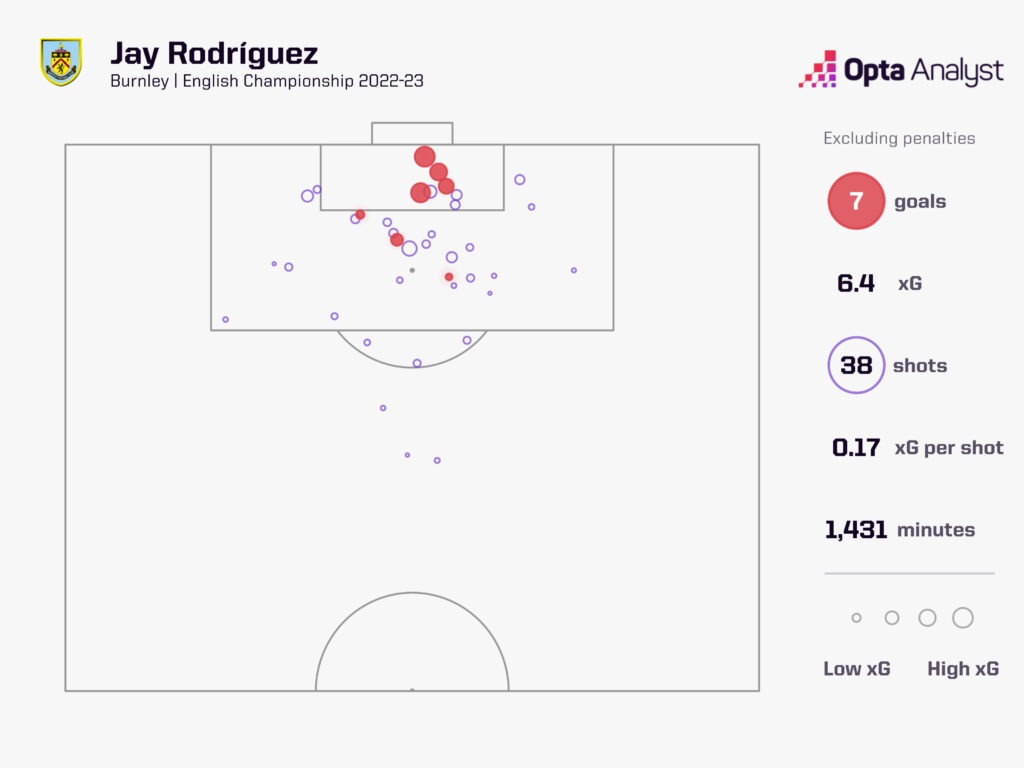
The very absence of a greedy, goal-hungry centre-forward, however, may be a factor behind the form of wide forwards Benson and Nathan Tella, who have seven apiece, plus Brownhill from midfield.
By comparison, Norwich have given 19 starts apiece to two orthodox centre-forwards in Josh Sargent and Teemu Pukki, who have scored nine and seven respectively.
Pukki has taken the second-most penalty-box shots per 90 minutes for Championship strikers with 10+ appearances at 2.9, while Sargent averages 2.1 per 90.
Viktor Gyokeres has had 38 18-yard area efforts for Coventry and has 10 goals for the season, but nobody for the Sky Blues has scored more than four.
Oli McBurnie averages 4.5 penalty box shots per game (excluding penalties), the most in the second tier, but him and Illiman Ndiaye have scored nine apiece with only Anel Ahmedhodzic the third-top scorer with four – two of which coming from set pieces.
Sometimes, the brisk goalscoring focus of one individual striker can impinge on the collective output, whereas Burnley have multiple threats, reflected in 13 different goalscorers.
Man Management
To a casual observer, it may seem as though Kompany didn’t excel at Anderlecht, the biggest club in Belgium, with fourth and third-placed finishes under his guidance.
The context, however, would be that there were plenty of issues at boardroom level which made it difficult for the Brussels giants to hit the heights some might have expected.
Plus, Kompany’s family at the time were still based in Manchester, and personal circumstances always have the capacity to impact professional output to some degree.
Despite perceived mediocre performance on paper, RSCA fans remained supportive of Kompany and were unhappy when he was sacked: they liked his ideas and felt he would have been the right person to take the club forward, partly because of his strength of character.
Whether in the press, speaking to fans or in the dressing room, Kompany will command a room: when he speaks, you listen.
It’s one thing Manchester City replacing Guardiola with a visionary coach, with innovative tactical ideas and elite coaching, but they must have the force of personality to motivate everyone to buy into their methods.
Kompany has that, and while his status as a City legend shouldn’t be the primary reason for appointing him, it does mean supporters will be onside from the outset.
Is Kompany’s Return to City a Realistic Option?
Some, understandably, might be reluctant to go too early on the Kompany bus – it might just be a Kompany car at the moment.
Many would want Guardiola’s eventual replacement to be proven in the Champions League, and one of the top five major leagues in Europe at a minimum, and the 36-year-old hasn’t passed that test yet.
Guardiola may choose to sign a new deal, Kompany may struggle to implement his methods in the Premier League much like two-time Championship title-winning manager Daniel Farke did with Norwich City, or City may choose a more experienced, proven option in 2025. All those things are very possible.
However, it would be simplistic to throw the suggestion of Kompany to City in the Lampard to Chelsea bracket.
Not only had Lampard had one season in the Championship with Derby before getting the big job, rather than three successful years as would have to be the case for Kompany, he hadn’t coached to the same standard.
Lamps’ 2018-19 Rams finished sixth in the second-tier, so a big part of him getting the job was outstanding individual EFL Cup performances against Chelsea and Manchester United that year.
The former midfielder’s side weren’t hugely creative as a unit, but relied on individual quality from Mason Mount, Harry Wilson and Tom Lawrence.
Derby weren’t typically scoring beautifully constructed team goals like Burnley are, which reflects superbly on the quality of coaching, rather fine strikes from range – or clinical finishing from Jack Marriott and Martyn Waghorn.
Kompany is already showing far more potential as a manager than Lampard did, and arguably Steven Gerrard, so while he’ll inevitably get labelled by parts of external media as someone relying on reputation if he gets a big job, the more nuanced reality is, on evidence so far, he’s a fantastic manager in his own right.
While City may be tempted by a more established name come 2025 – if there’s a vacancy – like Mikel Arteta and Julian Nagelsmann, Vinnie has a special connection with the club.
With a spirited bond underpinning potentially world-class management, Kompany could be the one to follow his guide – and inspire City to dominate England and Europe.
